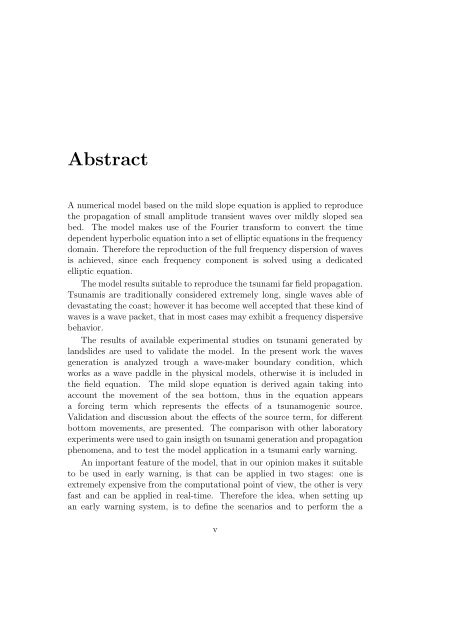Numerical modeling of waves for a tsunami early warning system
Numerical modeling of waves for a tsunami early warning system
Numerical modeling of waves for a tsunami early warning system
Create successful ePaper yourself
Turn your PDF publications into a flip-book with our unique Google optimized e-Paper software.
Abstract<br />
A numerical model based on the mild slope equation is applied to reproduce<br />
the propagation <strong>of</strong> small amplitude transient <strong>waves</strong> over mildly sloped sea<br />
bed. The model makes use <strong>of</strong> the Fourier trans<strong>for</strong>m to convert the time<br />
dependent hyperbolic equation into a set <strong>of</strong> elliptic equations in the frequency<br />
domain. There<strong>for</strong>e the reproduction <strong>of</strong> the full frequency dispersion <strong>of</strong> <strong>waves</strong><br />
is achieved, since each frequency component is solved using a dedicated<br />
elliptic equation.<br />
The model results suitable to reproduce the <strong>tsunami</strong> far field propagation.<br />
Tsunamis are traditionally considered extremely long, single <strong>waves</strong> able <strong>of</strong><br />
devastating the coast; however it has become well accepted that these kind <strong>of</strong><br />
<strong>waves</strong> is a wave packet, that in most cases may exhibit a frequency dispersive<br />
behavior.<br />
The results <strong>of</strong> available experimental studies on <strong>tsunami</strong> generated by<br />
landslides are used to validate the model. In the present work the <strong>waves</strong><br />
generation is analyzed trough a wave-maker boundary condition, which<br />
works as a wave paddle in the physical models, otherwise it is included in<br />
the field equation. The mild slope equation is derived again taking into<br />
account the movement <strong>of</strong> the sea bottom, thus in the equation appears<br />
a <strong>for</strong>cing term which represents the effects <strong>of</strong> a tsunamogenic source.<br />
Validation and discussion about the effects <strong>of</strong> the source term, <strong>for</strong> different<br />
bottom movements, are presented. The comparison with other laboratory<br />
experiments were used to gain insigth on <strong>tsunami</strong> generation and propagation<br />
phenomena, and to test the model application in a <strong>tsunami</strong> <strong>early</strong> <strong>warning</strong>.<br />
An important feature <strong>of</strong> the model, that in our opinion makes it suitable<br />
to be used in <strong>early</strong> <strong>warning</strong>, is that can be applied in two stages: one is<br />
extremely expensive from the computational point <strong>of</strong> view, the other is very<br />
fast and can be applied in real-time. There<strong>for</strong>e the idea, when setting up<br />
an <strong>early</strong> <strong>warning</strong> <strong>system</strong>, is to define the scenarios and to per<strong>for</strong>m the a<br />
v

















